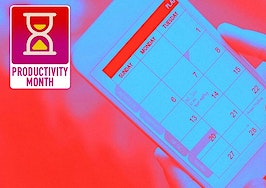 Virtual open houses, digital closings, conversations from behind face masks — what productivity looks like for real estate agents this summer covers new terrain for all of us. All June, Inman surveys the New Productivity: the tools, skills and insights needed to make it work now.
Virtual open houses, digital closings, conversations from behind face masks — what productivity looks like for real estate agents this summer covers new terrain for all of us. All June, Inman surveys the New Productivity: the tools, skills and insights needed to make it work now.
This article series is largely taken from the Real Estate Marketing Playbook with permission from the author.
What’s the good of investing in a CRM, putting in money, time and effort, if you’re not going to segment and organize your network of contacts accurately? Without crucial organization, you might as well throw the whole system away and go back to spreadsheets and Post-it notes. Your CRM will only work for you if you’re putting the work into it.
When thinking about segmenting your database, you want to ask yourself two questions: “How important is this person to my business?” and “How often do I want to talk to them?” Once you’ve got those answered, you can categorize and segment nearly everyone in your database so that you can get to work.
However, that does not answer the question of what exactly your segmentation should look like and how you’ll categorize the contacts in your network. Just knowing that a particular connection is essential to your business and that you’ll want to get in touch with them isn’t quite enough to build your segmentation categories.
But it does give you the framework of how to think about it. In addition to those two questions you’ll need to answer, here are a few categories to try out.
1. Family and friends
This is the easiest source of business for most agents, but often times, they’re neglected. Some agents assume that they’ll automatically get this business.
They don’t take the time to systematically follow up with their own friends and family, only to become frustrated when they see someone they know on a Facebook post writing about the home they sold. By regularly communicating with everyone you know, you’ll stay top-of-mind.
2. Past clients
What better source for referrals than past clients? Give this segment of your database particular attention several times a year to not only maintain those relationships, but also to get referrals and reviews.
I recommend a monthly newsletter — both physical and electronic — since unfortunately, the majority of email goes unread. Automated campaigns alone are not enough, though. It’s essential to be making contact in person or over the phone several times throughout the year. We’ve had a lot of success hosting two to three client appreciation events each year. But more on that later.
A-B-C method
Within our sphere of influence that includes friends, family and past clients, there is a hierarchy. The most important people in your database are your “A’s,” and those are your raving fans and huge advocates for your business.
You can rely on them for at least one transaction a year, so you’ll want to arm them with everything they need to spread the good word. They should be the first people you think of if you happen to have extra tickets to a sporting event, and it’s certainly worth taking them out to lunch or dinner every so often. Now, not everyone is as well-connected or willing to help promote you as your “A” group. It does take a specific personality type.
The next subset is “B.” These people have either done business with you in the past or have provided a referral that has resulted in closed business. It’s also important to stay top-of-mind with them by having a meaningful conversation at least once a quarter.
The majority of people in your sphere of influence will fall into the “C” category. These are people who would most likely do business with you, but haven’t had the opportunity lately. There is no category for “D” — D stands for delete.
Don’t waste time pursuing people who are not likely to do business with you, live out of your market area or just don’t match your personality type.
3. Hot leads
These are potential customers who are pretty much ready to do business any day now and should be contacted on a very regular basis. While you may not need to keep in touch with this segment of your database on a daily basis, it’s crucial to keep them up to date with any necessary information as they move through the sales process.
4. Warm leads
Not quite as ready as the hot leads, but this group is getting close. Consider your warm leads those who aren’t quite prepared to make the purchase yet but are showing interest. I try and keep in touch with this segment every three months to keep them warm with general updates, newsletters or check-ins in a more personal manner.
5. Cold leads
They aren’t dead, but for the time being, they’re cold. However, that doesn’t mean you should ignore them altogether. Set them up on an automated drip campaign, and then check in periodically.
Watch for increased activity such as opening your newsletters, clicking on links, viewing more homes on your website or an elevated seller score if you’re using a service such as First.io.
6. Referral partners
Local business people, other real estate agents and any other partners that you give referrals to and vice versa. Referrals are the lifeblood of the real estate business and maintaining a relationship for this segment is crucial to your success.
7. Catchall
Come across someone who doesn’t quite fit into any of the categories, but shouldn’t be removed from your database entirely? You’ll want to place them here.
This methodology is not a one-size-fits-all segmentation outline; part of building a database is making it personal for you. Without that personalization, you are less likely to make use of your database or CRM system, rendering it useless.
The most important thing to remember as you’re working through the segmentation process of your database is that nothing is set in stone. The best segmentation is one that’s always in flux because you’re keeping it up to date with your business.
Once your hot leads make it through your pipeline and have happily settled in their new home, it’s time to move them to your past clients segment and ask them for a referral or online review. Allowing for flexibility in your database segmentation will strengthen your database overall as you build it out to optimize your business.
Real Estate Marketing Playbook was inspired by observations and experiences over many years in the real estate business. This series includes example strategies from the playbook, and the full text is available on Amazon, Kindle and Audible.
Brandon Doyle is a Realtor at Doyle Real Estate Team — Re/Max Results in Minneapolis and co-author of Mindset, Methods & Metrics – Winning as a Modern Real Estate Agent. You can follow him on Twitter.









